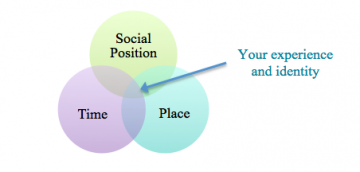To allow learners to explore different domains of their relationship to history, this guide presents the framework of time, place, and social position*. As illustrated in Figure 1, our experience and sense of identity are, in essence, products of the social space that we occupy in a particular time and place. These three domains – time, place, and social position – are not independent but rather interconnected with one another to shape our experiences and identities in a unique way.
For instance, the extent to and ways in which a woman experiences gender inequalities are specific to time and place. In Canada, many Aboriginal women are placed in an under-privileged social position compared to non-Aboriginal women, as seen in the ongoing outcry for equal rights and support for the investigation of murdered and missing Aboriginal women in Vancouver. This is deeply embedded in social structure and culture developed through the history of this place, including government legislations such as the Indian Act, Bill C-31. And yet, it is also important to remember that one’s social position in one place at one time in history is not fixed but rather fluid, multidimensional, and relative. For example, an Aboriginal woman may feel different dimensions of her identity – such as race, gender, physical dis/ability, sexual orientation – becoming more salient than other dimensions depending on with whom she interacts and the context of interaction. This user guide is designed to facilitate a learning process in which learners come to see the complexity and specificity of their presence and relations with others in the time and place that they occupy.
__________
* We use the term “social position” to refer to the position that one occupies in the social structure, recognizing its stratified nature along social group lines. Some may name this idea “social identity.” We use the term “social identity” in this user guide as well, but we limit the usage of the term to when we refer specifically to social group membership, such as male/female and hetero-/homo-sexual. We intentionally use the term “social position” here to emphasize that how we are positioned in society is unequal and specific to time and place.
